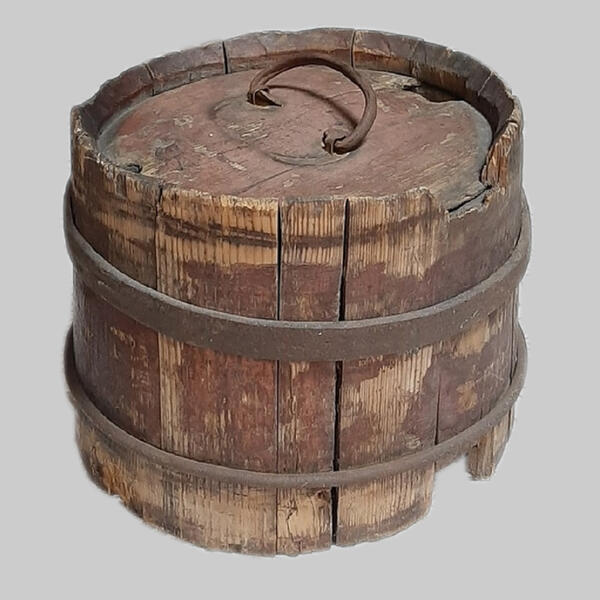This double-bottomed barrel came to the museum from Yekaterinburg. In one of its bottoms, there are two holes, i.e. round and rectangular. A metal handle in the form of a bracket is attached to the bottom. The barrel is tied with two metal hoops. The remains of a red-brown paint layer are visible on the vessel. The item presented was most likely used to transport water, kvass, and milk.
Cooperage is a very ancient craft that was used for making wooden dishes from rivets, i.e. long trapezoidal or rounded planks. Often coopers made special barrels with a double bottom and a round hole in one of the bottoms or in the middle of the rivet. These tubs were used for keeping and transporting drinking water, kvass, birch, and maple juice, as well as other beverages. The purpose of the vessel determined the choice of wood from which it was made. Barrels for braga, beer, and vegetable oil were made of oak. For water, they used spruce barrels, and for milk, honey, and caviar - linden barrels. Most often, small vessels from five to 120 liters were used in peasant life. Barrels were also used for washing clothes.
In similar oak barrels in the old days, water was taken to mowing. In such barrels, water remained cool longer. The wood was specially chosen so that the water ‘did not suffocate’ and kept fresh. The barrel was fixed horizontally in the cart, and to prevent water from spilling out, the filling hole in the rivet was gagged or plugged. In winter, especially in severe frosts, a thick layer of ice formed on the walls of the barrel from the inside, and the filling hole was also covered with ice. Therefore, in winter, water was carried in large tubs or vats, which were fixed on a sled.
In order to make the double-bottomed tub convenient to lift and carry, a metal or wooden handle was reinforced in the middle of the upper bottom. If the tub was tied with metal hoops, then the handle was made of carbon or stainless steel, and in case of wooden hoops, they made it from the wood of willow, rowanberry, or cherry. In the upper bottom of the tub, two holes were also drilled into which plugs were inserted. If one of the holes was used for liquid transfusion, the second one was used for free air circulation. It was due to this that the liquid flowed freely from the tilted tub in a uniform and continuous stream.
Cooperage is a very ancient craft that was used for making wooden dishes from rivets, i.e. long trapezoidal or rounded planks. Often coopers made special barrels with a double bottom and a round hole in one of the bottoms or in the middle of the rivet. These tubs were used for keeping and transporting drinking water, kvass, birch, and maple juice, as well as other beverages. The purpose of the vessel determined the choice of wood from which it was made. Barrels for braga, beer, and vegetable oil were made of oak. For water, they used spruce barrels, and for milk, honey, and caviar - linden barrels. Most often, small vessels from five to 120 liters were used in peasant life. Barrels were also used for washing clothes.
In similar oak barrels in the old days, water was taken to mowing. In such barrels, water remained cool longer. The wood was specially chosen so that the water ‘did not suffocate’ and kept fresh. The barrel was fixed horizontally in the cart, and to prevent water from spilling out, the filling hole in the rivet was gagged or plugged. In winter, especially in severe frosts, a thick layer of ice formed on the walls of the barrel from the inside, and the filling hole was also covered with ice. Therefore, in winter, water was carried in large tubs or vats, which were fixed on a sled.
In order to make the double-bottomed tub convenient to lift and carry, a metal or wooden handle was reinforced in the middle of the upper bottom. If the tub was tied with metal hoops, then the handle was made of carbon or stainless steel, and in case of wooden hoops, they made it from the wood of willow, rowanberry, or cherry. In the upper bottom of the tub, two holes were also drilled into which plugs were inserted. If one of the holes was used for liquid transfusion, the second one was used for free air circulation. It was due to this that the liquid flowed freely from the tilted tub in a uniform and continuous stream.



